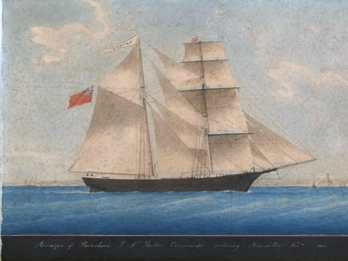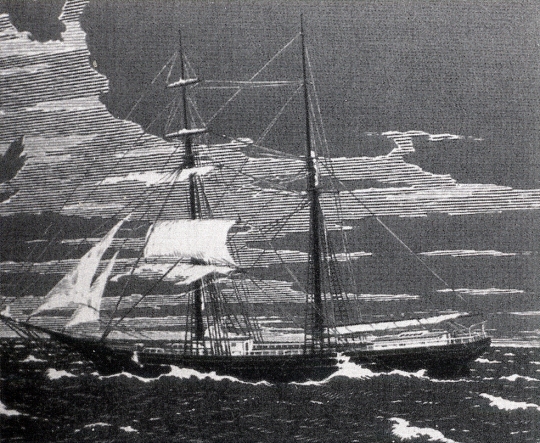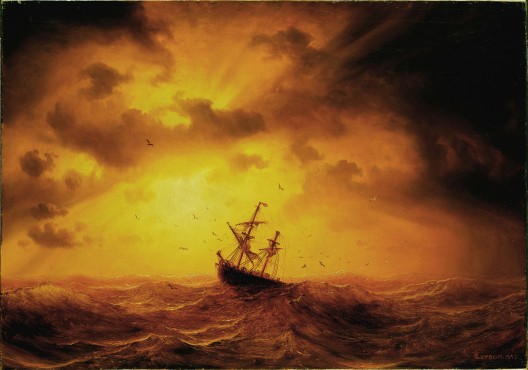We’re going to do something a little different this month. Instead of looking at a specific haunting or mythological figure, let’s talk about a mystery that has scared seafarers for over 100 years.

Painting of the actual Mary Celeste, back when she was named The Amazon. Courtesy of Wikimedia Commons.
The Mary Celeste is pretty famous, though I myself had never heard of her. Built in Nova Scotia around 1890, she was a ship some 100 feet long, rigged as a brigantine (for those of you [like me] who know less than nothing about boats, that means her sails were arranged so that she looked something like her picture to the left here). She set sail first with the name Amazon.
The ship proved herself unlucky almost as soon as she hit the water. Her first captain fell ill and died shortly after supervising the cargo load for her maiden voyage. Then her second captain collided her with a fishing boat. Then she ran into and sank a brig outside of London. Then a storm drove her to shore and damaged her so badly that her owners abandoned her as a wreck. Coming out of that, the Amazon was bought, repaired, upgraded, and christened with a new name: the Mary Celeste.
Another pro tip for us landlubbers: renaming a ship is supposed to bring terrible luck. Considering her already sketchy history, I’m not sure what drove the restorers of the Mary Celeste to tempt fate. But the stigma didn’t stop a flock of new investors, one of which who would become her new captain. His name was Benjamin Briggs.

Photo of Briggs, courtesy of Wikimedia Commons.
Briggs was a devout Christian and father of two children: one son, age 7 at the time, and a daughter, age 2. Briggs had considered retiring from seafaring and starting a business with his brother, but the call of the Mary Celeste was too seductive to ignore. With his wife, daughter, a cargo of industrial alcohol, and a crew of men described as “peaceable and first-class sailors,” Briggs set sail on his new ship for Genoa, Italy on November 7, 1872.
“Our vessel is in beautiful trim,” Briggs wrote to his mother before they left. “I hope we shall have a fine passage.”
Genoa was a popular destination; by coincidence, an acquaintance of Briggs named David Morehouse would set sail for it 8 days after the Mary Celeste left port. Like Briggs, Morehouse was an experienced and respected captain. So when, in the middle of his journey across the Atlantic, he spotted a ship with oddly set sails jerking through the water, he knew immediately that something was wrong.
Morehouse hailed the ship. No one replied. He drew closer, and saw that it was none other than the Mary Celeste. The deck lay empty. Morehouse signaled the ship again, and the only response was its irregular bobbing in the waves. Worried for his friend–there were pirates active in these waters, and the weather had been terrible–Morehouse sent his first mate Oliver Deveau over with another man to investigate. What they found still puzzles people today.

An engraving of how the Mary Celeste might have looked upon discovery, courtesy of Wikimedia Commons.
There were no obvious signs of attack or fire. The sails were partly set but in poor condition; a few were missing altogether. The rigging was damaged, with ropes hanging loosely over the sides. Something had smashed the glass over the compass, and a makeshift sounding rod (a tool for measuring how much water is in a hold) sat abandoned in the middle of the deck.
Deveau called out. The hull of the Marie Celeste groaned; her sails flapped wetly in the wind. Far away, the crew of his own ship watched expectantly. But there was no response.
Below, everything seemed to be in order, save for some water that had come in through the open windows to splatter the beds and the floor. Valuable personal items–including the captain’s sword–were all still there, as was a 6-month supply of food. According to some legends, half-eaten breakfasts still lay on the table, untouched by rot or flies.*
But no one was there. No bodies. No signs of violence. Deveau and his companion sloshed through 3 and a half feet of water accumulated in the hold–a significant amount, but by no means fatal for a ship of the Celeste’s size–and searched desperately for the missing crew. But the ship remained quiet. At last they could not escape the awful conclusion: they were on the Mary Celeste alone.

A photo of Sarah Briggs, Captain Brigg’s wife, with one of their children. Courtesy of Wikimedia Commons.
They found the ship’s log in the first mate’s cabin. The last entry was dated the morning of November 25, a little over a week previous. According to the coordinates provided there, the Celeste had moved an incredible 400 nautical miles since. The men were flabbergasted. They went back to the deck and noticed that the lifeboat was missing, as were most of the ship’s papers and navigational instruments. They supposed the crew–Briggs and his men, as well as his wife and toddler daughter–must have abandoned the ship in an awful hurry. But why? The Celeste was still sound. What had caused the seasoned, level-headed captain to panic?
The men returned to their own vessel to report their findings. Captain Morehouse, disturbed, decided at length to bring the Mary Celeste in to Gibraltar for salvage. With his crew divided between two ships, it was hard going. I can only imagine what it was like for those unlucky enough to have to man the silent Mary Celeste. When they finally arrived, Morehouse wrote to his wife: “I can hardly tell what I am made of, but I do not care so long as I got in safe.”
The team’s arrival ignited a firestorm of speculation about the fate of the Mary Celeste, one that has not really died down since. Select theories include:
-
-
- Pirate attack. Unlikely, as (as I mentioned) many food and valuables were still on board.
- Someone going insane and killing everyone. The person people point a finger at ranges from Briggs to Morehouse to some other member of the crew. Some said that whoever-it-was was fueled by an alcoholic rage (though the alcohol in the Celeste’s hold wasn’t drinkable, and Briggs ran a dry ship). Fiction writers (the fiends!) helped spread rumors with stories of “survivors” from the Celeste, but, as I mentioned, the evidence aboard the ship did not indicate violent attack. There were some stains on board that looked like blood but turned out (upon testing) not to be; some breaks in the wood initally thought to be ax marks that were more likely natural wear from the sea. Given also that Briggs, Morehouse, and the crew of the Mary Celeste were all known to be calm, even-tempered men, most people eventually dropped violence from the list of plausible explanations.
- Sea monsters. Giant sea squid! Other horrific things! But if that were the case, how would they have gotten everyone so neatly? And what about the lifeboat and navigational instruments?
- Water spouts. Apparently there is such a thing as a water tornado. That could work as an explanation, given the battered sails and how everything was soaked in the hold. But again, why jump ship? Did Briggs think it was sinking? Why abandon the relative safety of the larger ship for a rinky-dinky lifeboat?
- Miscellaneous supernatural occurrences. Ghosts. UFOs. Time warps. Bermuda-triangle-like hotspots hundreds of miles away from the actual bermuda triangle. Other things that cannot–must not--be named. ¯\_(ツ)_/¯
- Exploding cargo. Now we start to get into more sane explanations. Recent experiments have shown that if one of the industrial alcohol barrels leaked and exploded thanks to a large wave (or someone lighting a pipe a little too close by), it would create a big burst of flame but not necessarily burn or harm the ship in any discernible way. If such an explosion happened, Briggs would have been alarmed and gotten everyone off the ship, only to see the Celeste drift away and be lost in the lifeboat at sea. Investigators, not finding any burn marks, wouldn’t have been the wiser.
- Faulty equipment. Another more sane (but boring) theory where the Captain panics when he shouldn’t: if his compass was off and his water-measuring equipment was also off, leading him to believe that he was closer to land than he thought and that the Celeste was starting to sink when it wasn’t. In this theory, the banality of evil rules all: Briggs could have lost his life and the lives of his family and crew due to simple technical error.
-
- Whatever the cause, the result was the same: the souls aboard the Mary Celeste vanished for good.

Dramatic ship painting, courtesy of Wikimedia Commons.
So what happened to the ship itself? After an official inquiry, the Mary Celeste was sold in a hurry and continued to bring her rapidly changing captains ill fortune. She lost one full cargo of lumber in an accident, and then when she was used to try to ship livestock, almost every animal in her hold wasted away. When yet another captain died prematurely on her watch, her cursed reputation was sealed.
Finally, a man named Gilman C. Parker bought and ran her across a reef in an attempt at insurance fraud. Unfortunately for him, he and his associates were found out and vilified for it. Parker died in poverty less than a year later. One of his accomplices went to an insane asylum; the other committed suicide. And that was the last of the Mary Celeste, though certainly not the last of the curiosity over her.
There is an abundance of material to read about this stuff, for those of you who are interested. The Smithsonian has an interesting theory, as do several videos on Youtube. If you want to go down the rabbit hole, I’d start on the Wikipedia page and then go on from there. I myself am deep in it, and will probably never get out.
What do you think could have clear out the Mary Celeste without a trace? Extra points for fart jokes. Share your thoughts in the comments below.
*This is probably not true, but it does add a nice dramatic flair.
Featured image by Jacob Buchhave.





0 Comments